Myristica fragrans
Nutmeg
Pala
Nutmeg
Nutmeg is the seed or ground spice of several tree species of the genus Myristica; fragrant nutmeg or true nutmeg (M. fragrans) is a dark-leaved evergreen tree cultivated for two spices derived from its fruit: nutmeg, from its seed, and mace, from the seed covering. It is also a commercial source of nutmeg essential oil and nutmeg butter. Indonesia is the main producer of nutmeg and mace, and the true nutmeg tree is native to its islands.
If consumed in amounts exceeding its typical use as a spice, nutmeg powder may produce allergic reactions, cause contact dermatitis, or have psychoactive effects. Although used in traditional medicine for treating various disorders, nutmeg has no scientifically confirmed medicinal value.
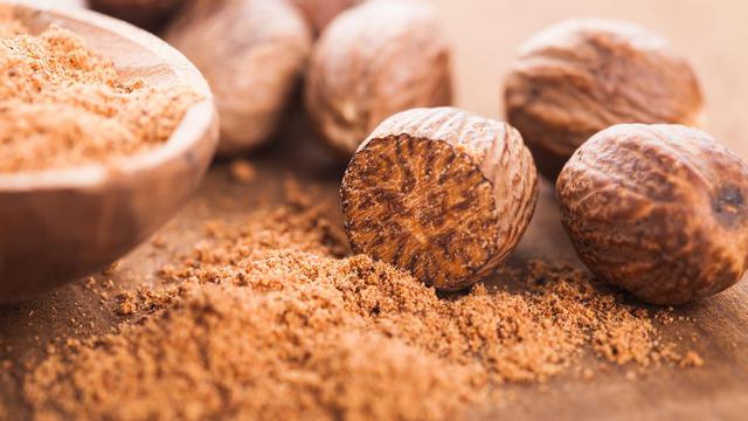 Common nutmeg
Nutmeg is the spice made by grinding the seed of the fragrant nutmeg tree (Myristica fragrans) into powder. The spice has a distinctive pungent fragrance and a warm, slightly sweet taste; it is used to flavor many kinds of baked goods, confections, puddings, potatoes, meats, sausages, sauces, vegetables, and such beverages as eggnog.
The seeds are dried gradually in the sun over a period of six to eight weeks. During this time the nutmeg shrinks away from its hard seed coat until the kernels rattle in their shells when shaken. The shell is then broken with a wooden club and the nutmegs are picked out. Dried nutmegs are grayish brown ovoids with furrowed surfaces. The nutmegs are roughly egg-shaped, about 20.5–30 mm (0.81–1.18 in) long and 15–18 mm (0.59–0.71 in) wide, weighing 5–10 g (0.18–0.35 oz) dried.
Two other species of genus Myristica with different flavors, M. malabarica and M. argentea, are sometimes used to adulterate nutmeg as a spice.
Common nutmeg
Nutmeg is the spice made by grinding the seed of the fragrant nutmeg tree (Myristica fragrans) into powder. The spice has a distinctive pungent fragrance and a warm, slightly sweet taste; it is used to flavor many kinds of baked goods, confections, puddings, potatoes, meats, sausages, sauces, vegetables, and such beverages as eggnog.
The seeds are dried gradually in the sun over a period of six to eight weeks. During this time the nutmeg shrinks away from its hard seed coat until the kernels rattle in their shells when shaken. The shell is then broken with a wooden club and the nutmegs are picked out. Dried nutmegs are grayish brown ovoids with furrowed surfaces. The nutmegs are roughly egg-shaped, about 20.5–30 mm (0.81–1.18 in) long and 15–18 mm (0.59–0.71 in) wide, weighing 5–10 g (0.18–0.35 oz) dried.
Two other species of genus Myristica with different flavors, M. malabarica and M. argentea, are sometimes used to adulterate nutmeg as a spice.
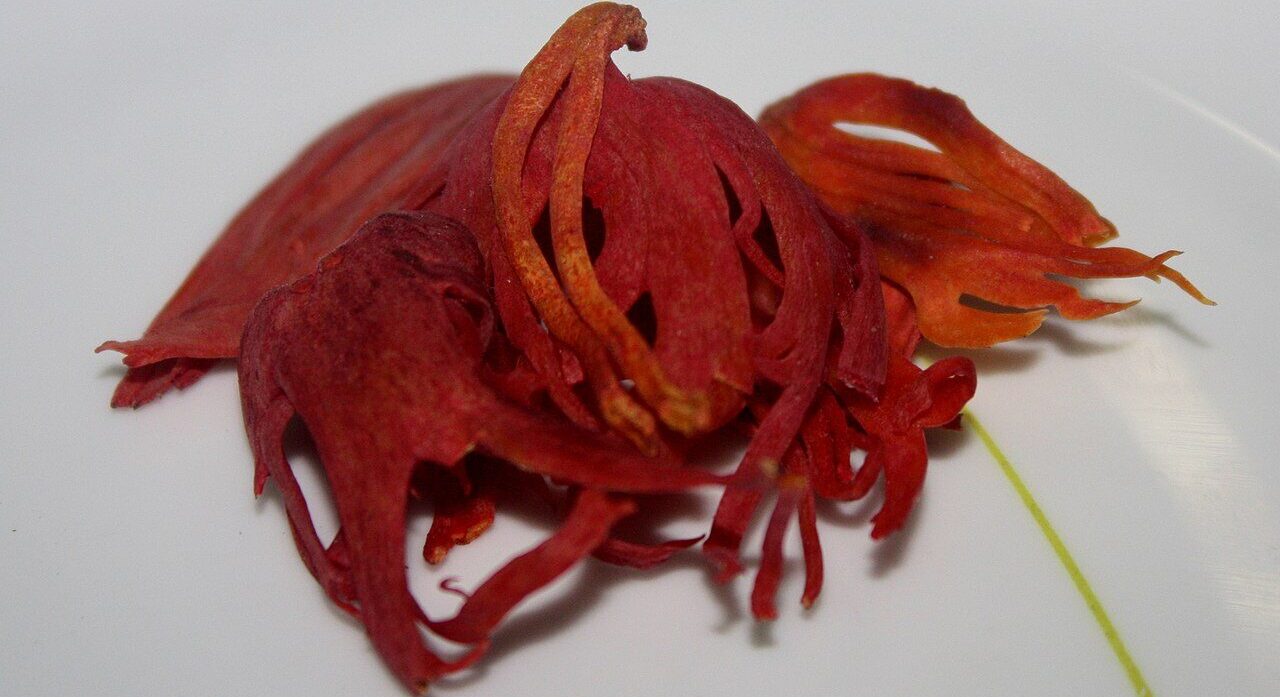 Mace
Mace is the spice made from the reddish seed covering (aril) of the nutmeg seed. Its flavour is similar to nutmeg but more delicate; it is used to flavour baked goods, meat, fish, and vegetables, and in preserving and pickling.
In the processing of mace, the crimson-colored aril is removed from the nutmeg seed that it envelops and is flattened out and dried for 10 to 14 days. Its color changes to pale yellow, orange, or tan. Whole dry mace consists of flat pieces—smooth, horn-like, and brittle—about 40 mm (1+1⁄2 in) long.
Mace
Mace is the spice made from the reddish seed covering (aril) of the nutmeg seed. Its flavour is similar to nutmeg but more delicate; it is used to flavour baked goods, meat, fish, and vegetables, and in preserving and pickling.
In the processing of mace, the crimson-colored aril is removed from the nutmeg seed that it envelops and is flattened out and dried for 10 to 14 days. Its color changes to pale yellow, orange, or tan. Whole dry mace consists of flat pieces—smooth, horn-like, and brittle—about 40 mm (1+1⁄2 in) long.
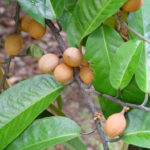
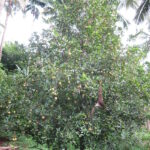
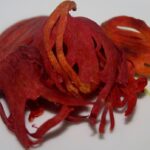
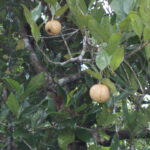
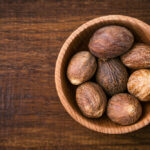
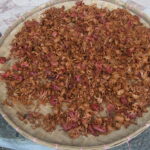
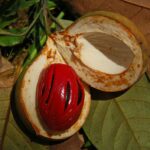

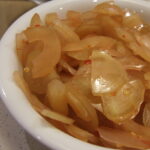
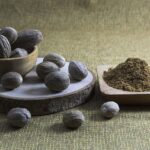
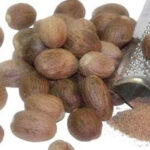
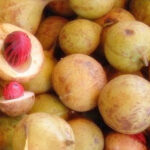
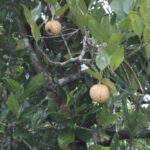
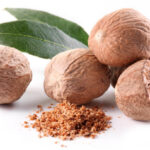
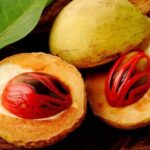
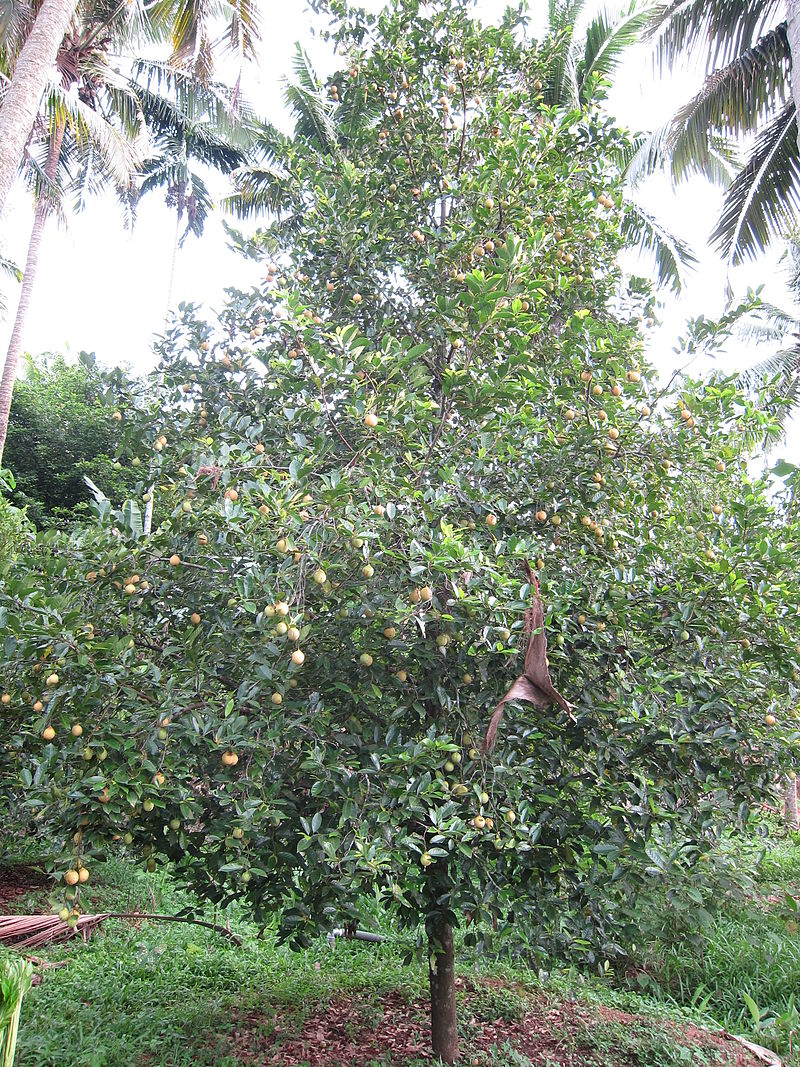 Botany and cultivation
The most important commercial species is the common, true or fragrant nutmeg, Myristica fragrans (Myristicaceae), native to the Moluccas (or Spice Islands) of Indonesia. It is also cultivated on Penang Island in Malaysia, in the Caribbean, especially in Grenada, and in Kerala, a state formerly known as Malabar in ancient writings as the hub of spice trading, in southern India. In the 17th-century work Hortus Botanicus Malabaricus, Hendrik van Rheede records that Indians learned the usage of nutmeg from the Indonesians through ancient trade routes.
Nutmeg trees are dioecious plants (individual plants are either male or female) which are propagated sexually from seeds and asexually from cuttings or grafting. Sexual propagation yields 50% male seedlings, which are unproductive. Because there is no reliable method of determining plant sex before flowering in the sixth to eighth year, and sexual reproduction bears inconsistent yields, grafting is the preferred method of propagation.
Botany and cultivation
The most important commercial species is the common, true or fragrant nutmeg, Myristica fragrans (Myristicaceae), native to the Moluccas (or Spice Islands) of Indonesia. It is also cultivated on Penang Island in Malaysia, in the Caribbean, especially in Grenada, and in Kerala, a state formerly known as Malabar in ancient writings as the hub of spice trading, in southern India. In the 17th-century work Hortus Botanicus Malabaricus, Hendrik van Rheede records that Indians learned the usage of nutmeg from the Indonesians through ancient trade routes.
Nutmeg trees are dioecious plants (individual plants are either male or female) which are propagated sexually from seeds and asexually from cuttings or grafting. Sexual propagation yields 50% male seedlings, which are unproductive. Because there is no reliable method of determining plant sex before flowering in the sixth to eighth year, and sexual reproduction bears inconsistent yields, grafting is the preferred method of propagation.
 Epicotyl grafting (a variation of cleft grafting using seedlings), approach grafting, and patch budding have proved successful, with epicotyl grafting being the most widely adopted standard. Air layering is an alternative though not preferred method because of its low (35–40%) success rate.
The first harvest of nutmeg trees takes place seven to nine years after planting, and the trees reach full production after twenty years.
Although used as a folk treatment for some ailments, nutmeg has no proven medicinal value.
In 2019, global production of nutmeg was 142,000 tonnes, led by Indonesia, Guatemala, and India, having 38,000 to 43,000 tonnes each and a combined 85% of the world total.
Psychoactivity and toxicity
Epicotyl grafting (a variation of cleft grafting using seedlings), approach grafting, and patch budding have proved successful, with epicotyl grafting being the most widely adopted standard. Air layering is an alternative though not preferred method because of its low (35–40%) success rate.
The first harvest of nutmeg trees takes place seven to nine years after planting, and the trees reach full production after twenty years.
Although used as a folk treatment for some ailments, nutmeg has no proven medicinal value.
In 2019, global production of nutmeg was 142,000 tonnes, led by Indonesia, Guatemala, and India, having 38,000 to 43,000 tonnes each and a combined 85% of the world total.
Psychoactivity and toxicity
(Hectares) Area
0
(Tons) Production
0
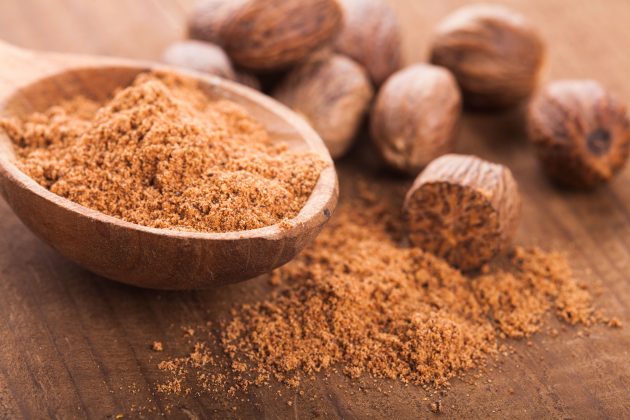 Spice
Nutmeg and mace have similar sensory qualities, with nutmeg having a slightly sweeter and mace a more delicate flavour. Mace is often preferred in light dishes for the bright orange, saffron-like hue it imparts. Nutmeg is used for flavouring many dishes. Whole nutmeg can also be ground at home using a grater specifically designed for nutmeg or a multi-purpose grating tool.
Spice
Nutmeg and mace have similar sensory qualities, with nutmeg having a slightly sweeter and mace a more delicate flavour. Mace is often preferred in light dishes for the bright orange, saffron-like hue it imparts. Nutmeg is used for flavouring many dishes. Whole nutmeg can also be ground at home using a grater specifically designed for nutmeg or a multi-purpose grating tool.
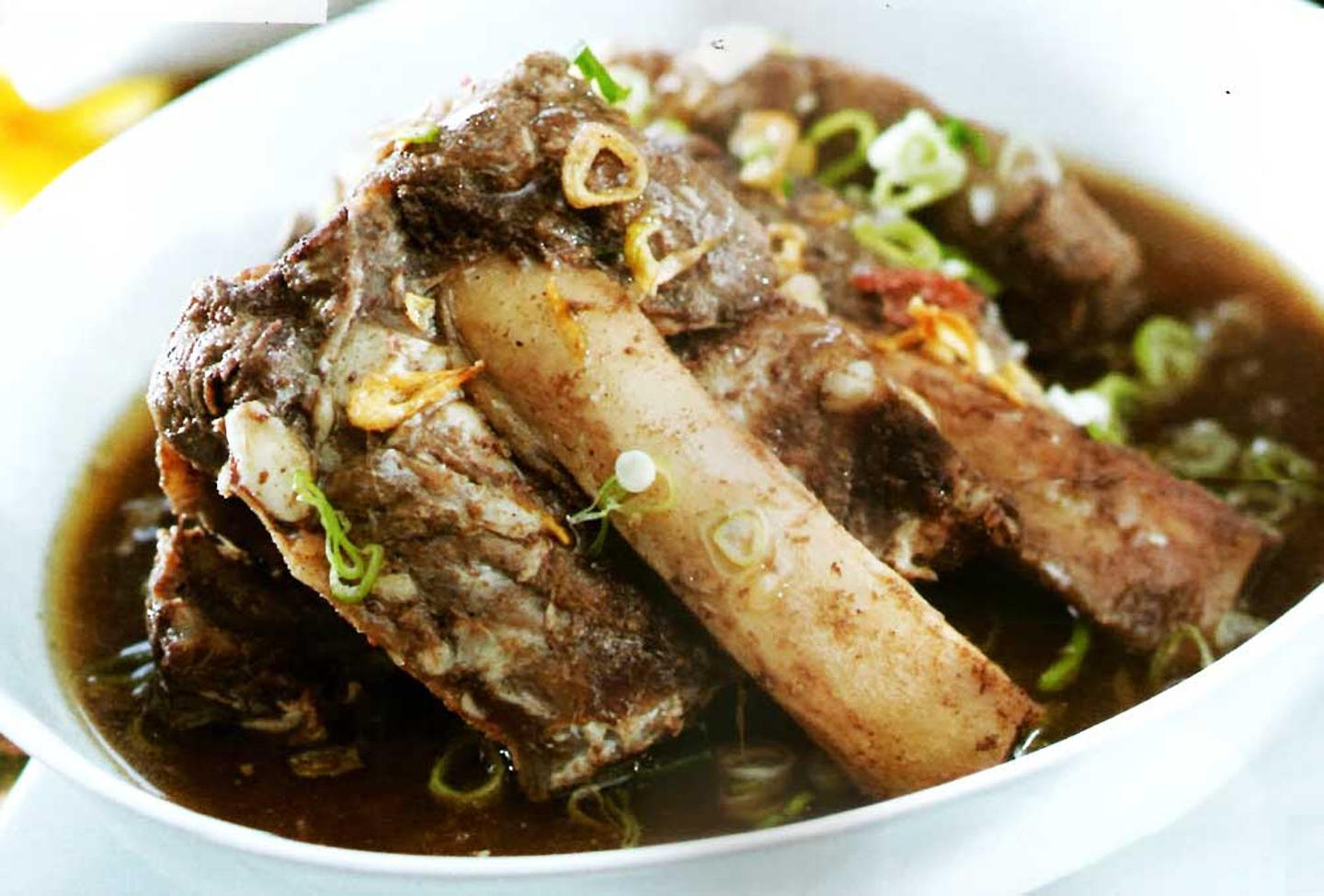 In Indonesian cuisine, nutmeg is used in dishes, such as spicy soups including variants of soto, konro, oxtail soup, sup iga (ribs soup), bakso, and sup kambing. It is also used in gravy for meat dishes, such as semur, beef stew, ribs with tomato, and European derived dishes such as bistik (beef steak), rolade (minced meat roll), and bistik lidah (beef tongue steak).
In Indian cuisine, nutmeg is used in many sweet, as well as savoury, dishes. In Kerala Malabar region, grated nutmeg is used in meat preparations and also sparingly added to desserts for the flavour. It may also be used in small quantities in garam masala. Ground nutmeg is also smoked in India.
In Indonesian cuisine, nutmeg is used in dishes, such as spicy soups including variants of soto, konro, oxtail soup, sup iga (ribs soup), bakso, and sup kambing. It is also used in gravy for meat dishes, such as semur, beef stew, ribs with tomato, and European derived dishes such as bistik (beef steak), rolade (minced meat roll), and bistik lidah (beef tongue steak).
In Indian cuisine, nutmeg is used in many sweet, as well as savoury, dishes. In Kerala Malabar region, grated nutmeg is used in meat preparations and also sparingly added to desserts for the flavour. It may also be used in small quantities in garam masala. Ground nutmeg is also smoked in India.
 In traditional European cuisine, nutmeg and mace are used especially in potato and spinach dishes and in processed meat products; they are also used in soups, sauces, and baked goods. It is also commonly used in rice pudding.
In Dutch cuisine, nutmeg is added to vegetables such as Brussels sprouts, cauliflower, and string beans. Nutmeg is a traditional ingredient in mulled cider, mulled wine, junket and eggnog.
In traditional European cuisine, nutmeg and mace are used especially in potato and spinach dishes and in processed meat products; they are also used in soups, sauces, and baked goods. It is also commonly used in rice pudding.
In Dutch cuisine, nutmeg is added to vegetables such as Brussels sprouts, cauliflower, and string beans. Nutmeg is a traditional ingredient in mulled cider, mulled wine, junket and eggnog.
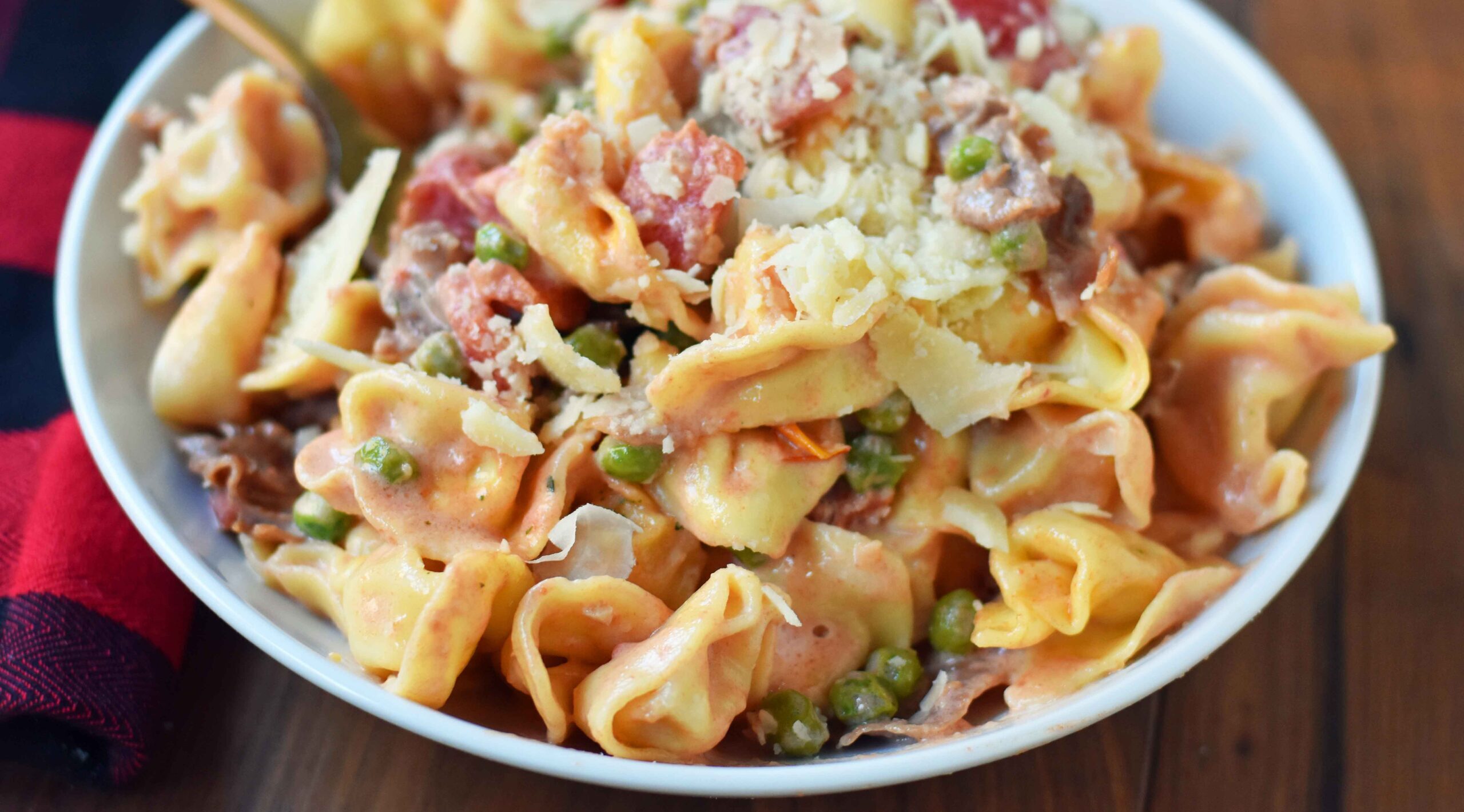 In Scotland, mace and nutmeg are usually both ingredients in haggis.
In Italian cuisine, nutmeg is used as part of the stuffing for many regional meat-filled dumplings like tortellini, as well as for the traditional meatloaf. Nutmeg is a common spice for pumpkin pie and in recipes for other winter squashes, such as baked acorn squash.
In the Caribbean, nutmeg is often used in drinks, such as the Bushwacker, Painkiller, and Barbados rum punch. Typically, it is a sprinkle on top of the drink.
In Scotland, mace and nutmeg are usually both ingredients in haggis.
In Italian cuisine, nutmeg is used as part of the stuffing for many regional meat-filled dumplings like tortellini, as well as for the traditional meatloaf. Nutmeg is a common spice for pumpkin pie and in recipes for other winter squashes, such as baked acorn squash.
In the Caribbean, nutmeg is often used in drinks, such as the Bushwacker, Painkiller, and Barbados rum punch. Typically, it is a sprinkle on top of the drink.
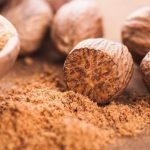
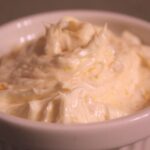
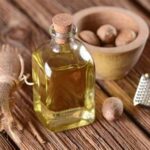

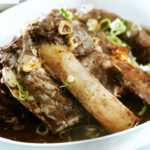

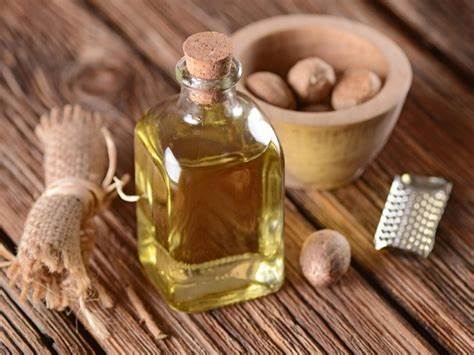 Essential oil
The essential oil obtained by steam distillation of ground nutmeg is used in the perfumery and pharmaceutical industries. The volatile fraction contains dozens of terpenes and phenylpropanoids, including d-pinene, limonene, d-borneol, l-terpineol, geraniol, safrol, and myristicin. In its pure form, myristicin is a toxin, and consumption of excessive amounts of nutmeg can result in myristicin poisoning.
The oil is colorless or light yellow, and smells and tastes of nutmeg. It is used as a natural food flavoring in baked goods, syrups, beverages, and sweets. It is used to replace ground nutmeg, as it leaves no particles in the food. The essential oil is also used in the manufacturing of toothpaste and cough syrups.
Essential oil
The essential oil obtained by steam distillation of ground nutmeg is used in the perfumery and pharmaceutical industries. The volatile fraction contains dozens of terpenes and phenylpropanoids, including d-pinene, limonene, d-borneol, l-terpineol, geraniol, safrol, and myristicin. In its pure form, myristicin is a toxin, and consumption of excessive amounts of nutmeg can result in myristicin poisoning.
The oil is colorless or light yellow, and smells and tastes of nutmeg. It is used as a natural food flavoring in baked goods, syrups, beverages, and sweets. It is used to replace ground nutmeg, as it leaves no particles in the food. The essential oil is also used in the manufacturing of toothpaste and cough syrups.
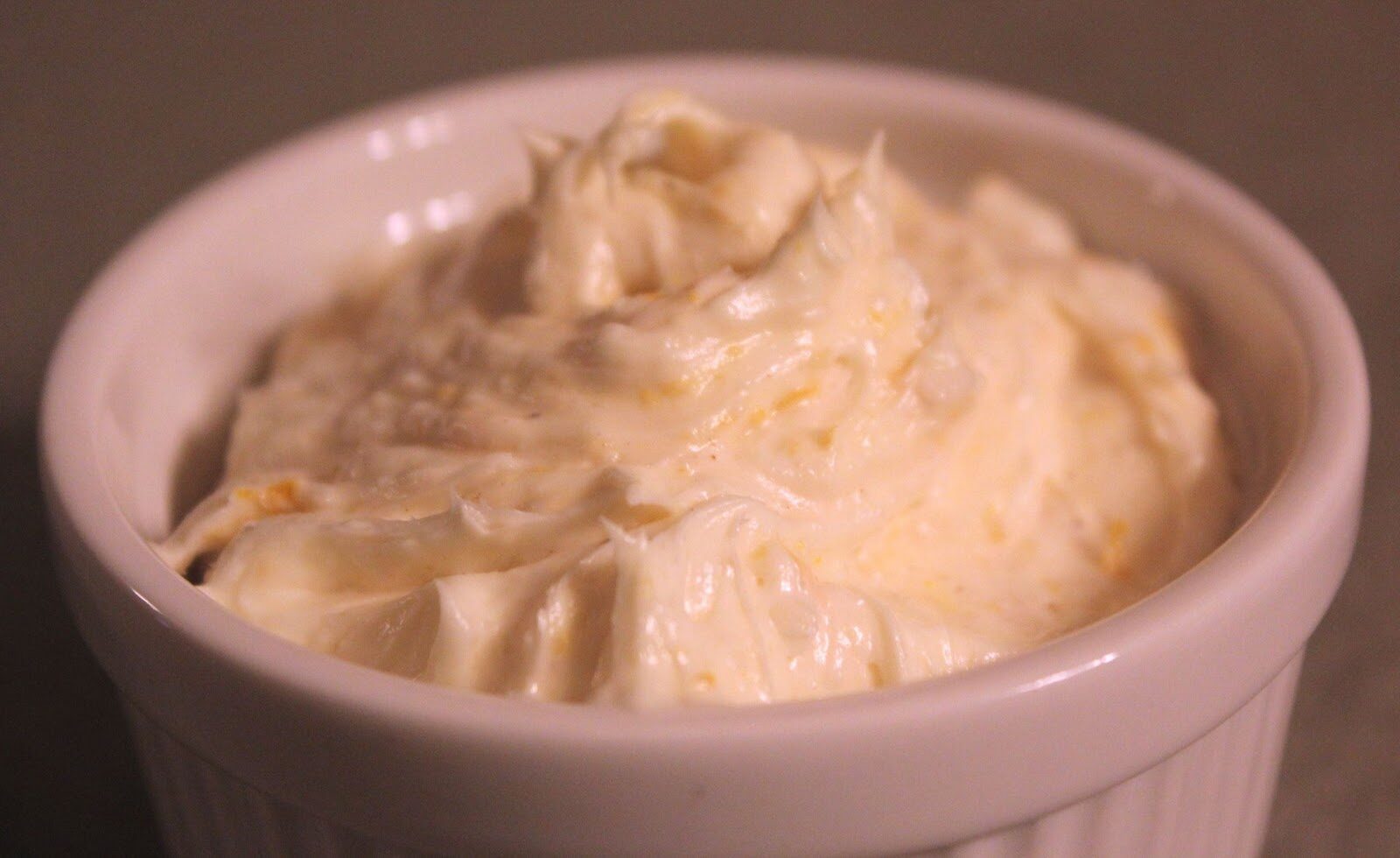 Nutmeg butter
Nutmeg butter is obtained from the nut by expression. It is semisolid, reddish-brown in colour, and has the taste and smell of nutmeg itself. About 75% (by weight) of nutmeg butter is trimyristin, which can be turned into myristic acid, a 14-carbon fatty acid, which can be used as a replacement for cocoa butter, can be mixed with other fats like cottonseed oil or palm oil, and has applications as an industrial lubricant.
One cup of 218 grams of Nutmeg butter is loaded with 1927 calories, 218 g of Total lipid fat, 0.44 mg of Vitamin E, 196.2 g of total saturated fats, 6.758 g of lauric acid, 180.068 g of myristic acid, 9.374 g of palmitic acid, 10.464 g of total monounsaturated fats and 10.464 g of oleic acid.
Nutmeg butter
Nutmeg butter is obtained from the nut by expression. It is semisolid, reddish-brown in colour, and has the taste and smell of nutmeg itself. About 75% (by weight) of nutmeg butter is trimyristin, which can be turned into myristic acid, a 14-carbon fatty acid, which can be used as a replacement for cocoa butter, can be mixed with other fats like cottonseed oil or palm oil, and has applications as an industrial lubricant.
One cup of 218 grams of Nutmeg butter is loaded with 1927 calories, 218 g of Total lipid fat, 0.44 mg of Vitamin E, 196.2 g of total saturated fats, 6.758 g of lauric acid, 180.068 g of myristic acid, 9.374 g of palmitic acid, 10.464 g of total monounsaturated fats and 10.464 g of oleic acid.
